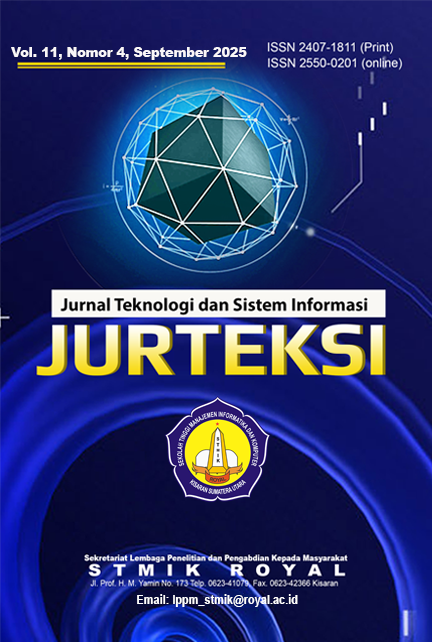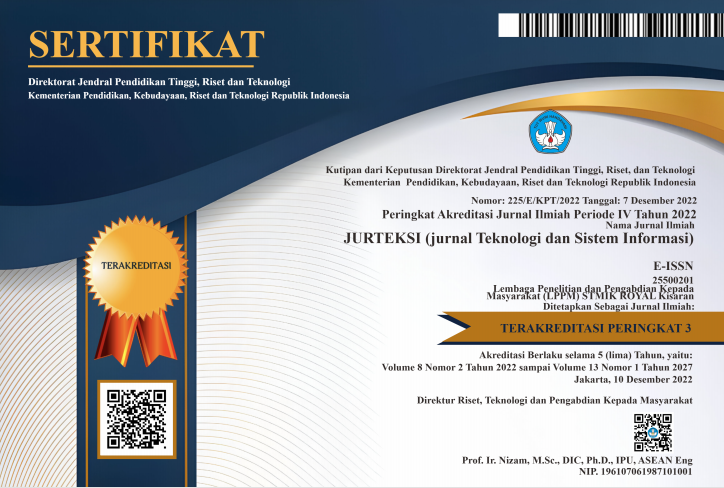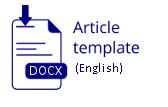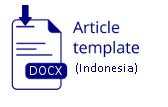COMPARISON OF K-MEANS AND K-MEDOIDS FOR DRUG DATA CLUSTERING
Abstract
Abstract: Ineffective drug demand management can lead to problems such as imbalanced drug distribution, excess stock, or shortages in community health centers. To address this, data mining can be utilized to support the planning and control process of drug inventory. Clustering techniques were chosen because they are able to group drug data based on certain characteristics, thus identifying stable and unstable drug supply patterns. This study aims to group drug data at Simpang Kawat Community Health Center in Jambi City, which can be used as a reference in planning drug needs in the next period. Data grouping is divided into three categories: slow-moving, medium-moving, and fast-moving. The research data includes attributes of drug name, initial stock, receipt, inventory, usage, and final stock, with a total of 1758 data sets, which were processed using the CRISP-DM framework through the RapidMiner application. Cluster quality evaluation was carried out using the Davies-Bouldin Index (DBI). The results showed that the K-Means algorithm obtained a DBI value of 0.175, smaller than K-Medoids which obtained a value of 0.354. Because a smaller DBI value indicates better cluster quality, K-Means provides more optimal clustering results than K-Medoids. Through these clustering results, community health centers can utilize drug cluster information to support more efficient drug procurement planning, as well as reduce the risk of excess or shortage of stock.
Keywords: data mining; clustering; k-means; k-medoids; davies-bouldin index
References
[2] Peraturan Menteri Kesehatan RI No 43 tahun 2019, “Peraturan Menteri Kesehatan RI No 43 tahun 2019 tentang Puskesmas,” Peratur. Menteri Kesehat. RI No 43 tahun 2019 tentang Puskesmas, vol. Nomor 65, no. 879, pp. 2004–2006, 2019.
[3] F. Ferlanda, “Implementasi Data Mining Untuk Menentukan Persediaan Stok Obat Di Apotek Enok Menggunakan Metode K-Means Clustering,” JATISI (Jurnal Tek. Inform. dan Sist. Informasi), vol. 8, no. 3, pp. 1294–1306, 2021, doi: 10.35957/jatisi.v8i3.1066.
[4] BPOM, “BPOM, ‘Materi Edukasi tentang Peduli Obat dan Pangan Aman,’ GNPOPA (Gerakan Nas. Peduli Obat Dan Pangan Aman), vol. 1, no. 1.,” p. 5.
[5] S. Michael Alexander Justin Audison Sibaran, I Gede Susrama Mas Diyasa, “Penggunaan K-Means Dan Hierarchical Clustering,” vol. 5, no. 2, pp. 1286–1294, 2024.
[6] I. Awaluddin, Y. L. Labangu, and Firdayanti, “Analisis Sistem Pengendalian Internal atas Persediaan Obat-Obatan (Studi pada Puskesmas Kecamatan Tiworo Kepulauan),” J. Akunt. dan Keuang., vol. 08, no. 02, pp. 133–141, 2023, [Online]. Available: http://jak.uho.ac.id/index.php/journal
[7] E. Saha and P. Rathore, “Discovering hidden patterns among medicines prescribed to patients using Association Rule Mining Technique,” Int. J. Healthc. Manag., vol. 16, no. 2, pp. 277–286, 2023.
[8] A. Ardiansyah, A. T. Zy, and A. Nugroho, “Implementasi Data Mining Algoritma Apriori Pada Sistem Persediaan Obat (Studi Kasus Klinik Pratama Keluarga Kesehatan),” J. Inf. Syst. Applied, Manag. Account. Res., vol. 7, no. 3, pp. 777–788, 2023.
[9] A. Supriyadi, A. Triayudi, and I. D. Sholihati, “Perbandingan Algoritma K-Means Dengan K-Medoids Pada Pengelompokan Armada Kendaraan Truk Berdasarkan Produktivitas,” JIPI (Jurnal Ilm. Penelit. dan Pembelajaran Inform., vol. 6, no. 2, pp. 229–240, 2021, doi: 10.29100/jipi.v6i2.2008.
[10] K. A. Kholil, N. Rahaningsih, and R. D. Dana, “Penerapan Data Mining Untuk Clustering Penyakit Diare Menggunakan Algoritma K-Means,” JATI (Jurnal Mhs. Tek. Inform., vol. 8, no. 3, pp. 3124–3131, 2024.
[11] E. Widodo and W. Hadikristanto, “Pengelompokan Untuk Penjualan Obat Dengan Menggunakan Algoritma K-Means,” Bull. Inf. Technol., vol. 4, no. 3, pp. 408–413, 2023.
[12] A. A. Islami and S. Ramadhani, “Rancang Bangun Sistem Pendataan Hardware,” J. Teknol. Dan Sist. Inf. Bisnis, vol. 3, no. 2, pp. 412–418, 2021, doi: 10.47233/jteksis.v3i2.300.
[13] S. M. Ramadhan, S. Ramadhani, and T. Z, “Perancangan Website Masyarakat Peduli Sampah Kelurahan Ratu Sima,” J. Penelit. Dan Pengkaj. Ilm. Eksakta, vol. 1, no. 1, pp. 40–49, 2022, doi: 10.47233/jppie.v1i1.424.
[14] F. Fathurrahman, “Evaluasi Clustering K-Means dan K-Medoid pada persebaran Covid-19 di Indonesia dengan metode Davies Bouldin Index (DBI),” 2023, Universitas Islam Negeri Maulana Malik Ibrahim.
[15] Mardalius, “Pengelompokan Data Penjualan Aksesoris Menggunakan Algoritma K-Means,” Jurteksi, vol. IV, no. 2, pp. 401–411, 2018.
[16] R. D. Firdaus, T. G. Laksana, and R. D. Ramadhani, “Pengelompokan Data Persediaan Obat Menggunakan Perbandingan Metode K-Means Dengan Hierarchical Clustering Single Linkage.,” J. Informatics, Inf. Syst. Softw. Eng. Appl., vol. 2, no. 1, pp. 33–48, 2019.
[17] A. Fira, C. Rozikin, and G. Garno, “Komparasi Algoritma K-Means dan K-Medoids Untuk Pengelompokkan Penyebaran Covid-19 di Indonesia,” J. Appl. Informatics Comput., vol. 5, no. 2, pp. 133–138, 2021, doi: 10.30871/jaic.v5i2.3286.
[18] A. Azevedo and M. F. Santos, “KDD, SEMMA and CRISP-DM: a parallel overview,” IADS-DM, 2008













